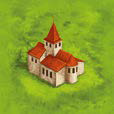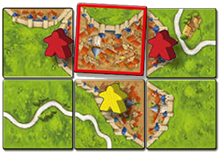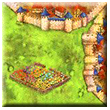Print-and-Play Demo
General info and comments
Originally released by Hans im Glück in 2020.
It is a free print-and-play demo game:
- Print out the tiles included in the PDF rules (see links below) on thick paper, or glue the printouts to cardboard and cut them out carefully.
- You will need different-colored pieces. Each player needs 5 pieces of the same color. The original game contains these little wooden pawn which we call "meeples".
- You can also create a scoreboard (also included in the PDF rules) on which you can display the points during the game. To use this scoreboard, you will need another character in each player color. You can also record your scores on paper.
- This demo game has fewer (48 instead of 72) and smaller tiles. It is also played with fewer meeples (5 instead of 7) than the original Carcassonne. The rules are otherwise the same, and are found below.
- In the basic game there are also rules for advanced players and 2 mini-expansions included.
The tiles and the scoreboard are included in pages 2 to 4 of the rulebook available here:
- English version:
- German version:
The tile distribution is the same as the one for Carcassonne for 2.
Components and setup
Following part will explain initial setup and introduce components of the game.
There are 48 LAND TILES which depict roads, cities, and monasteries, all of which are generally surrounded by fields.
Every tile shares the same back with the exception of the start tile which you should mark on the back making it easy to set it aside.
Place the start tile (the one you marked) in the middle of the table. Shuffle the remaining tiles and set them as different facedown stacks that are easily accessible to all players. Tiles can also be placed into a sack or game box and drawn randomly.
Then comes the scoreboard, which you set to the side of your playing surface.
Finally, we have the meeples. For this game, you need 5 pieces of the same color for each player. You will also need 1 additional piece for each player, which you place on space 0 of the scoreboard.
| Meeples |
Overview and goal of the game
In Carcassonne, players take turns placing tiles and expanding the landscape of roads, cities, monasteries and fields, one tile at a time. Players may place their meeples on the individual features of tiles as well (roads, cities and monasteries), where they will become highwaymen, knights and monks. Points are earned throughout the game, and the player with the highest score at the end is the winner.
Gameplay
A game of Carcassonne is played in clockwise order. Starting with the youngest player [1], the current player does the following actions in the order listed below, after which it is the next player’s turn, and so on and so forth. First, we’ll give you a brief description of the actions you have to do during one of your turns. These actions will be detailed as we present the roads, the cities, and finally the monasteries. So what are these actions?
1. Placing a tile
| The player must draw exactly one land tile from a stack and place it faceup adjacent to any tile already on the board to continue the landscape. [2] |
The roads
1. Placing a tile
You draw the depicted tile with three road segments starting from a village. You must place it in such a way that it continues the existing landscape (the tiles already in play). In the rare case that a tile cannot legally be placed anywhere, and all players agree, it is removed from the game, and the player draws another. [3]
2. Placing a meeple as highwayman
After placing the tile, you may place a meeple as a highwayman on one of that tile's road segments, but only if the road is not occupied by another highwayman.
In our example, since the road is not yet completed, no scoring occurs (see action 3) and play moves on to the next player.
The next player draws a tile that he/she places to continue the landscape. They may not place a meeple on the road to the right since your highwayman is already present on that road. Instead, they choose to place their meeple as a knight in the city segment of that tile.
3. Scoring a road
When both ends of a road are closed, that road is completed and scored. The end of a road is closed when it meets a village, [4] a city, a monastery, or it loops onto itself by meeting the other end.
Even though it is your opponent that placed the tile, this still completes your road. How many points do you score? When scoring a road, each tile of that road grants you 1 point. Here, since you scored a road that is made out of 3 tiles, you score 3 points.
It is now time to note your score. You keep track of your score with the meeple you placed on the scoreboard before starting the game. Continuing our example, you move it forward 3 spaces to show that you've scored 3 points. Note: if your score passes 50 points, lay down your scoring meeple to show your 50+ points.
After each scoring, return to your supply the meeple that was just scored.
We've already seen the most important parts of the game. Now, we will further expand on those actions by showing you how they apply to the other features, namely the cities and the monasteries.
The cities
2. Placing a meeple as a knight
Then, you see if there is already a meeple as a knight in the city. Here, there isn’t, so you can place one of your meeples as a knight in this city.
3. Scoring a city
Let's continue our example and assume that a few turns have passed. You now draw this tile that you place to continue your city. Since the tile you’ve placed completes a feature (here, the city), it must now be scored. A city is completed when it is surrounded by walls and there are no gaps inside the city. Since you have a meeple in the completed city, you are the player to score it.
Each tile in a completed city is worth 2 points. In addition, each coat of arms is worth 2 more points. [5] For this city, you score 8 points. As usual, the meeple that was in the scored feature returns to your supply.
The monasteries
1. Placing a tile
Once more, you draw a tile to continue the landscape. Monasteries are always depicted in the center of a tile. When placing such a tile, you must, as usual, make sure that it continues the illustration. [6]
3. Scoring a monastery
A monastery is completed when it is surrounded by tiles. During scoring, the monastery is worth 1 point per tile that completes it (including the monastery itself).
By placing this tile, you complete your monastery. It earns you 9 points and allows you to take your meeple back.
Summary
1. Placing a tile
- You must place your drawn tile in such a way that it continues the landscape and the illustration.
- In some very rare cases, it may be impossible to place the tile. In those cases, simply return the tile to the box and draw a new one.
2. Placing a meeple
- You may place a meeple on the tile you’ve just placed.
- You may not place a meeple in a feature where there already is at least one other meeple, including one of yours.
3. Scoring a feature
- A road is completed when both ends lead to a village, a city, a monastery, or the road forms a loop. Each tile in a completed road is worth 1 point.
- A city is completed when it is surrounded by walls and there are no holes inside the city. Each tile in the completed city is worth 2 points. Each coat of arms in the completed city is worth an extra 2 points.
- A monastery is completed when it is surrounded by 8 tiles. Each of the monastery’s tiles (the 8 surrounding tiles and the one with the monastery itself) is worth 1 point.
- Scoring always occurs at the end of a player’s turn. At that moment, each player with a meeple in a scored feature earns points. [7]
- After each scoring, return to your supply the scored meeples.
- If there are multiple meeples in a single scored feature, the player with the most meeples is awarded full points and all other players receive nothing. When more than one player have the most meeples in a scored feature, the tied players all score full points.
Special cases
Use a meeple, score a feature, and get the meeple back
You can place a meeple in a feature you just completed, immediately score it, and then return the meeple to your supply.
To do so, follow these steps:
__ 1. Place a tile, completing a feature (such as a road, city, or monastery).
__ 2. Place a meeple as a highwayman, knight, or monk on the feature you just completed.
__ 3. Score the completed road, city, or monastery and return the meeple to your supply.
![]() Question: There is a situation that puzzles us. If a player draws a tile with two city segments and completes a small city, earning 4 points, can he or she then deploy a meeple to a new city segment in the same turn?
Question: There is a situation that puzzles us. If a player draws a tile with two city segments and completes a small city, earning 4 points, can he or she then deploy a meeple to a new city segment in the same turn?
Many meeples on the same road
Many meeples in the same city

Game end and final scoring
The game ends immediately after the turn of the player who placed the last tile. Then, players proceed to a final scoring, after which the winner will be known.
Once the game is over, all meeples still in play are scored:
- Each incomplete road is worth 1 point per tile, just like during the game.
- Each incomplete city is worth 1 point per tile and 1 point per coat of arms, which is only half the points.
- Each incomplete monastery is worth 1 point plus 1 point per adjacent tile, just like during the game.

- Left city: Green is the only one to score 8 points (5 tiles and 3 coat of arms). Black does not score any points since Green has the most meeples in this city.
- Monastery: Yellow scores 4 points for this incomplete monastery (3 points for the adjacent tiles and 1 point for the monastery itself).
- Right city: Blue scores 3 points for this incomplete city (2 tiles and 1 coat of arms).
- Road: Red scores 3 points for this incomplete roads (3 tiles).
Once the final score is known, the winner is the player with the most points.[8]
House rules
- The players decide who starts the game by any method they choose—such as by rolling three meeples. The first player to ‘roll’ a standing meeple decides who plays first. (Thanks to Joff.)
- To determine the first player; each player draws a tile from the bag, the player that drew the tile with the most roads (0 to 4) plays first, if there is a tie for most roads, a draw-off takes place. This is repeated until someone wins. (Thanks to michael.)
- Take your next tile at the end of your turn, to give you time to think about placement and avoid analysis paralysis.
- Play with a three-tile hand. The abbey counts as part of your hand. Play your turn, including the builder, and then draw back up to three tiles. These tiles could be visible to all or hidden to the other players (Thanks to DavidP and youtch.)
- When playing with a bag for the tiles, the original starting tile may be put into the bag, and unplayable tiles can be put back into the bag rather than set to one side. (Thanks to dwhitworth.)
- When a tile is the only tile which can currently complete a structure, other players can offer to ‘buy’ it by offering points, trades counter, abbey, and so on. (Thanks to Deatheux.)
- If you place a tile that fills a hole in the playing field by touching something on all four adjacent sides, you get another turn. This helps motivate people to finish the board even if they do not get an advantage from the placement. (Does not apply to the abbey tile). (Thanks to viberunner.)
- Incomplete features at the end of the game do not score points at the end of the game. (Thanks to metoth.)
- The edge of the table limits the playing area. Thus, a player may not place a tile past the edge of the table or move the playing area to place a tile that would have been past the edge of the table. (Thanks to metoth for prompting this one, and to SkullOne for pointing out that this is an official rule from Hunters and Gatherers.)
- Table borders COMPLETE features as an abbey would. (Thanks to PreGy.)
- Use colored dice instead of meeples on the scoring track. Start out with the 6 showing on top. When the marker completes one lap, turn it to the number 1 to indicate it has completed one lap. This shows at a glance which player is on what lap and who's ahead. On the 100 space track it’s even easier to determine someone’s score at a glance. (Thanks to Carcking.)
Tile distribution
Footnotes
For Icons explanation and licensing please visit Icons page.
- ↑
 It is common practice to choose starting player at random. More on this in house rules section.
It is common practice to choose starting player at random. More on this in house rules section.
- ↑
 A newly placed land tile must fit the adjacent terrain on all edges! During placement it is not enough to look for only one side that fits.
A newly placed land tile must fit the adjacent terrain on all edges! During placement it is not enough to look for only one side that fits.
- ↑
 If drawing tiles out of a bag, a tile that cannot be placed could be returned to the bag for later use.
If drawing tiles out of a bag, a tile that cannot be placed could be returned to the bag for later use.
- ↑
 Village is a little set of red roofed buildings surrounding the crossroad.
Village is a little set of red roofed buildings surrounding the crossroad.
- ↑
 Note that a coat of arms only affects the city segment it is in, not the whole tile (if there is more than one segment on a single tile).
Note that a coat of arms only affects the city segment it is in, not the whole tile (if there is more than one segment on a single tile).
- ↑
 Monasteries can be placed directly next to each other, or corner to corner. It is not necessary for there to be eight other (non-monastery) tiles neighbouring a monastery. A monastery stands in the middle of a field segment and other segments can be placed next to it. In contrast to roads, cities, and fields, it is not possible to connect to a monastery.
Monasteries can be placed directly next to each other, or corner to corner. It is not necessary for there to be eight other (non-monastery) tiles neighbouring a monastery. A monastery stands in the middle of a field segment and other segments can be placed next to it. In contrast to roads, cities, and fields, it is not possible to connect to a monastery.
- ↑
 When two meeples of one color are occupying the same road or city, you do not score double in these cases. The number of meeples has no effect on the points that a player earns from a road or city. Two knights do not double the points. The number of meeples is only important in establishing who has the majority.
When two meeples of one color are occupying the same road or city, you do not score double in these cases. The number of meeples has no effect on the points that a player earns from a road or city. Two knights do not double the points. The number of meeples is only important in establishing who has the majority.
- ↑
 Rules do not include tiebreakers. That is rules explaining situation when few players share the same score.
Rules do not include tiebreakers. That is rules explaining situation when few players share the same score.



























































